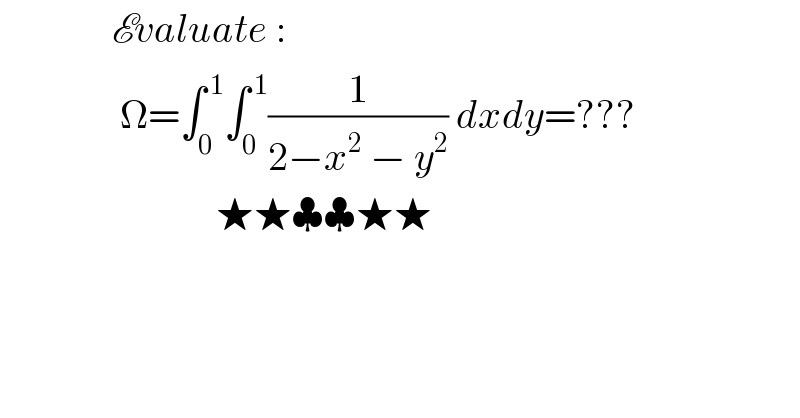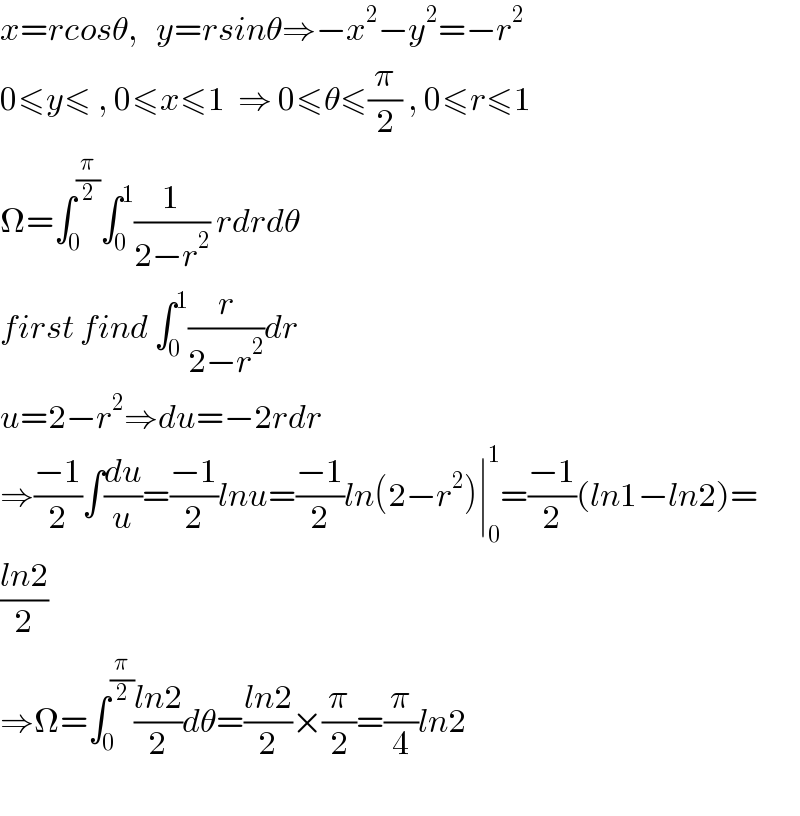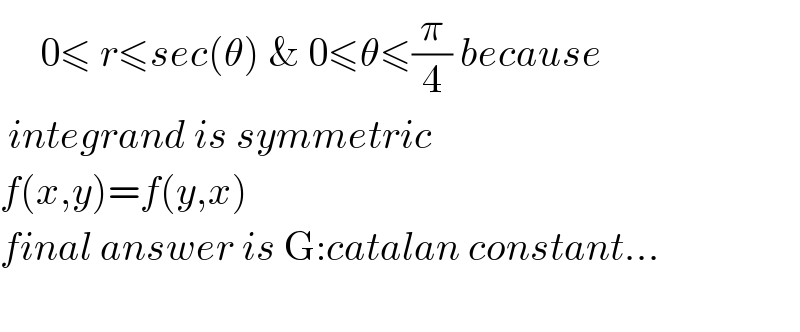
Question Number 108954 by mnjuly1970 last updated on 20/Aug/20

$$\:\:\:\:\:\:\:\:\:\:\:\:\:\:\mathscr{E}{valuate}\:: \\ $$$$\:\:\:\:\:\:\:\:\:\:\:\:\:\:\:\Omega=\int_{\mathrm{0}} ^{\:\mathrm{1}} \int_{\mathrm{0}} ^{\:\mathrm{1}} \frac{\mathrm{1}}{\mathrm{2}−{x}^{\mathrm{2}} \:−\:{y}^{\mathrm{2}} }\:{dxdy}=???\:\:\: \\ $$$$\:\:\:\:\:\:\:\:\:\:\:\:\:\:\:\:\:\:\:\:\:\:\:\:\:\:\:\bigstar\bigstar\clubsuit\clubsuit\bigstar\bigstar \\ $$$$ \\ $$
Commented by kaivan.ahmadi last updated on 20/Aug/20

$${x}={rcos}\theta,\:\:\:{y}={rsin}\theta\Rightarrow−{x}^{\mathrm{2}} −{y}^{\mathrm{2}} =−{r}^{\mathrm{2}} \\ $$$$\mathrm{0}\leqslant{y}\leqslant\:,\:\mathrm{0}\leqslant{x}\leqslant\mathrm{1}\:\:\Rightarrow\:\mathrm{0}\leqslant\theta\leqslant\frac{\pi}{\mathrm{2}}\:,\:\mathrm{0}\leqslant{r}\leqslant\mathrm{1} \\ $$$$\Omega=\int_{\mathrm{0}} ^{\frac{\pi}{\mathrm{2}}} \int_{\mathrm{0}} ^{\mathrm{1}} \frac{\mathrm{1}}{\mathrm{2}−{r}^{\mathrm{2}} }\:{rdrd}\theta \\ $$$${first}\:{find}\:\int_{\mathrm{0}} ^{\mathrm{1}} \frac{{r}}{\mathrm{2}−{r}^{\mathrm{2}} }{dr} \\ $$$${u}=\mathrm{2}−{r}^{\mathrm{2}} \Rightarrow{du}=−\mathrm{2}{rdr} \\ $$$$\Rightarrow\frac{−\mathrm{1}}{\mathrm{2}}\int\frac{{du}}{{u}}=\frac{−\mathrm{1}}{\mathrm{2}}{lnu}=\frac{−\mathrm{1}}{\mathrm{2}}{ln}\left(\mathrm{2}−{r}^{\mathrm{2}} \right)\mid_{\mathrm{0}} ^{\mathrm{1}} =\frac{−\mathrm{1}}{\mathrm{2}}\left({ln}\mathrm{1}−{ln}\mathrm{2}\right)= \\ $$$$\frac{{ln}\mathrm{2}}{\mathrm{2}} \\ $$$$\Rightarrow\Omega=\int_{\mathrm{0}} ^{\frac{\pi}{\mathrm{2}}} \frac{{ln}\mathrm{2}}{\mathrm{2}}{d}\theta=\frac{{ln}\mathrm{2}}{\mathrm{2}}×\frac{\pi}{\mathrm{2}}=\frac{\pi}{\mathrm{4}}{ln}\mathrm{2} \\ $$$$ \\ $$
Commented by mnjuly1970 last updated on 20/Aug/20

$$\:\:\:\:\:\mathrm{0}\leqslant\:{r}\leqslant{sec}\left(\theta\right)\:\&\:\mathrm{0}\leqslant\theta\leqslant\frac{\pi}{\mathrm{4}}\:{because} \\ $$$$\:{integrand}\:{is}\:{symmetric}\:\: \\ $$$${f}\left({x},{y}\right)={f}\left({y},{x}\right) \\ $$$${final}\:{answer}\:{is}\:\mathrm{G}:{catalan}\:{constant}... \\ $$$$ \\ $$
Commented by kaivan.ahmadi last updated on 20/Aug/20

$${Hi}\:{sir},{why}\:{do}\:{we}\:{use}\:{a}\:{dificult}\:{way}\:{when}\:{we}\:{have}\:{a} \\ $$$${have}\:{a}\:{simple}\:{way}? \\ $$
Commented by mathmax by abdo last updated on 20/Aug/20

$$\mathrm{0}\leqslant\mathrm{x}\leqslant\mathrm{1}\:\mathrm{and}\:\mathrm{0}\leqslant\mathrm{y}\leqslant\mathrm{1}\:\Rightarrow\mathrm{0}\leqslant\mathrm{x}^{\mathrm{2}} \:+\mathrm{y}^{\mathrm{2}} \leqslant\mathrm{2}\:\Rightarrow\mathrm{0}\leqslant\mathrm{r}\leqslant\sqrt{\mathrm{2}}'..! \\ $$
Commented by kaivan.ahmadi last updated on 21/Aug/20

$${study}\:{polar}\:{coordinate}\:{system}\:{please}. \\ $$
Answered by mathmax by abdo last updated on 20/Aug/20
![Ω =∫_0 ^1 ∫_0 ^1 ((dxdy)/(2−x^2 −y^2 )) we considere the diffeomorphism { ((x =rcosθ _(⇒ ) Ω =∫∫ _(o≤r≤(√2)and 0≤θ≤(π/2)) (1/(2−r^2 ))r dr dθ)),((y =rsinθ)) :} =(π/2)∫_0 ^(√2) ((rdr)/((2−r^2 ))) =−(π/4) ∫_0 ^(√2) ((−2r)/(2−r^2 ))dr =−(π/4)[ln∣2−r^2 ∣]_0 ^(√2) =∞ this integral is divergent...](Q109055.png)
$$\Omega\:=\int_{\mathrm{0}} ^{\mathrm{1}} \:\int_{\mathrm{0}} ^{\mathrm{1}} \:\frac{\mathrm{dxdy}}{\mathrm{2}−\mathrm{x}^{\mathrm{2}} −\mathrm{y}^{\mathrm{2}} }\:\:\mathrm{we}\:\mathrm{considere}\:\mathrm{the}\:\mathrm{diffeomorphism} \\ $$$$\begin{cases}{\mathrm{x}\:=\mathrm{rcos}\theta\:\:\:\:\:\:\:\:\:\:\:_{\Rightarrow\:\:} \Omega\:=\int\int\:_{\mathrm{o}\leqslant\mathrm{r}\leqslant\sqrt{\mathrm{2}}\mathrm{and}\:\:\mathrm{0}\leqslant\theta\leqslant\frac{\pi}{\mathrm{2}}} \:\:\:\:\frac{\mathrm{1}}{\mathrm{2}−\mathrm{r}^{\mathrm{2}} }\mathrm{r}\:\mathrm{dr}\:\mathrm{d}\theta}\\{\mathrm{y}\:=\mathrm{rsin}\theta}\end{cases} \\ $$$$=\frac{\pi}{\mathrm{2}}\int_{\mathrm{0}} ^{\sqrt{\mathrm{2}}} \:\:\frac{\mathrm{rdr}}{\left(\mathrm{2}−\mathrm{r}^{\mathrm{2}} \right)}\:=−\frac{\pi}{\mathrm{4}}\:\int_{\mathrm{0}} ^{\sqrt{\mathrm{2}}} \:\:\:\frac{−\mathrm{2r}}{\mathrm{2}−\mathrm{r}^{\mathrm{2}} }\mathrm{dr}\:=−\frac{\pi}{\mathrm{4}}\left[\mathrm{ln}\mid\mathrm{2}−\mathrm{r}^{\mathrm{2}} \mid\right]_{\mathrm{0}} ^{\sqrt{\mathrm{2}}} \:=\infty \\ $$$$\mathrm{this}\:\mathrm{integral}\:\mathrm{is}\:\mathrm{divergent}...\:\: \\ $$
